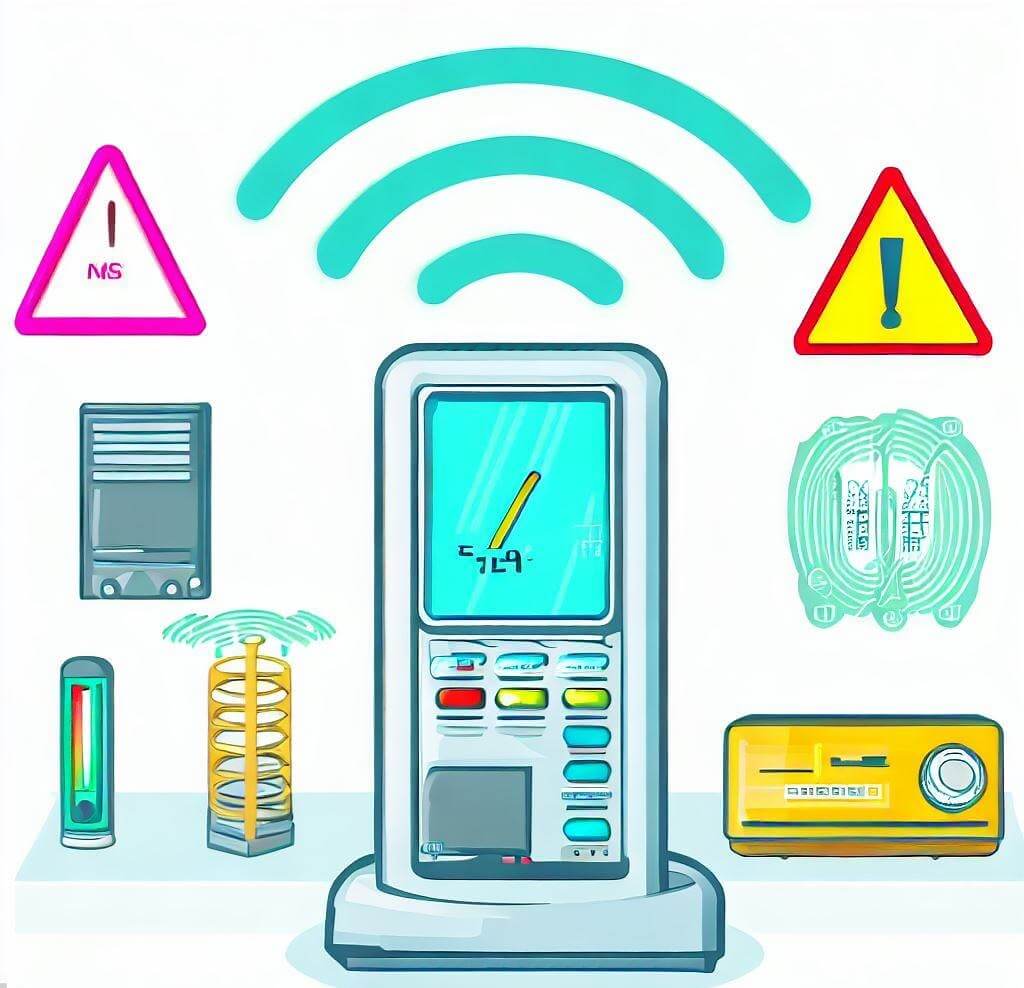In the increasingly tech-centric world we live in, EMF, or Electromagnetic Fields, have become a constant presence. While they’re a natural part of our environment, many of the devices we use daily significantly increase our exposure levels. Let’s delve into the world of EMFs to better understand their origins and manage our interactions with them.
Understanding Electromagnetic Fields (EMFs)
Before we can discuss the sources of EMF, it’s essential to understand what EMFs are.
What are EMFs?
EMFs are invisible areas of energy, often referred to as radiation, that are associated with the use of electrical power and various forms of natural and artificial lighting.
The Electromagnetic Spectrum
EMFs are part of the broader electromagnetic spectrum, which encompasses a range of phenomena like radio waves, microwaves, X-rays, and visible light.
Natural Sources of EMF
EMFs aren’t purely an artificial occurrence. They are a fundamental part of the natural world.
The Earth’s Magnetic Field
Our planet generates its own electromagnetic field, which is vital for life. It protects us from the harmful solar radiation that bombards the Earth daily.
Lightning
Lightning storms are another natural source of EMFs. They generate significant electromagnetic energy that can be detected as static on AM radios during a storm.
Artificial Sources of EMF
While there are natural sources of EMFs, it’s the artificial sources related to human activity that often concern us due to their proximity and frequency of use.
Household Appliances
Everyday household appliances are a common source of EMFs. These include items like refrigerators, ovens, hairdryers, and vacuum cleaners. Even your Wi-Fi router emits EMFs.
Telecommunication Devices
In our digital age, telecommunication devices are everywhere, from the smartphone in your pocket to the laptop on your desk. These devices use radio frequency (RF) EMFs to send and receive signals.
Power Lines
Overhead and underground power lines produce low-frequency EMFs. The strength of these fields decreases rapidly with distance, so those living or working close to power lines could experience higher exposure levels.
Medical Devices
Some medical equipment, such as MRI scanners, generate strong EMFs. These fields serve essential functions in diagnostics and treatment, but exposure is usually brief and controlled.
EMFs in the Medical Field
It’s worth noting that while we often discuss the potential health risks of EMFs, these fields also have beneficial applications, particularly in the medical field. This may seem paradoxical, but the difference lies in how they’re used.
Therapeutic Uses of EMF
Certain types of electromagnetic fields are used therapeutically in medicine. For example, Pulsed Electromagnetic Field Therapy (PEMF) is a non-invasive treatment used for various conditions, including bone healing, osteoarthritis, and depression. This therapy involves using specific EMF frequencies to stimulate the body’s healing process.
Diagnostic Uses of EMF
EMFs also play a critical role in diagnostic procedures. MRI (Magnetic Resonance Imaging), a common diagnostic technique, uses a strong magnetic field and radio waves to generate detailed images of structures within the body.
The point is, EMFs aren’t inherently harmful. Our understanding and application of them can lead to remarkable advances. However, the focus should be on understanding the potential risks of everyday EMF exposure from various sources and how we can mitigate those risks.
Remember, education is the key. The more we understand about EMFs, the better we can navigate our technologically saturated world.

The Rising EMF Source: 5G Technology
A new and significant source of EMFs is the latest 5G cellular technology. While it promises lightning-fast internet speeds, it also raises concerns over increased EMF exposure.
Understanding 5G EMF
5G technology uses higher frequency bands on the electromagnetic spectrum compared to its predecessors. This means the energy levels of the emitted EMFs are higher, leading to potential health concerns.
The Future of 5G and EMF
As 5G networks expand, so too will our exposure to EMFs. It’s a field that scientists are closely studying to understand the potential long-term effects on human health.
EMFs from Natural Sources
While we often focus on man-made EMFs, it’s crucial to note that natural sources also generate EMFs.
The Earth’s Magnetic Field
The Earth itself is a significant source of EMFs. Our planet’s magnetic field protects us from solar radiation and contributes to our navigation abilities. This magnetic field extends from the inner core out into space, forming the magnetosphere.
Cosmic Rays
Cosmic rays are high-energy protons and atomic nuclei that come from the sun and stars outside of our solar system. These particles travel at nearly the speed of light and produce EMFs.
Human Body
Even the human body produces EMFs! Our nervous system and heart have electrical activities which generate low-frequency electromagnetic fields.
How Can We Minimize Our Exposure to EMFs?
Since EMFs are virtually everywhere, it might seem impossible to avoid them. But there are practical steps we can take to reduce our exposure.
Maintaining Distance
The strength of EMFs reduces rapidly with distance. So, keeping a safe distance from sources, especially when they’re in use, can significantly lower your exposure.
Using Wired Connections
Where possible, opt for wired connections instead of wireless. Wired connections produce fewer EMFs than their wireless counterparts.
Limiting Usage
Limiting the usage of EMF-emitting devices, especially those held close to the body like mobile phones, can help reduce your EMF exposure.
EMF Shielding
Various products claim to shield against EMFs, from paints and fabrics to specific gadgets. However, their effectiveness can vary, and they should not replace the other mitigation methods mentioned above.

Government Regulations and Standards
Governments worldwide have established guidelines for EMF exposure. These are designed to protect the public and workers from the potential health effects of EMFs.
International Guidelines
Internationally recognized bodies, such as the International Commission on Non-Ionizing Radiation Protection (ICNIRP), set recommended exposure limits for EMFs. These guidelines are used by many countries to develop their national standards.
U.S. Standards
In the United States, the Federal Communications Commission (FCC) regulates the amount of EMF that electronic devices can emit.
EU Standards
In the European Union, Directive 2013/35/EU lays down minimum health and safety requirements regarding the exposure of workers to EMFs.
EMF Measurement and Detection
Knowing where EMFs come from isn’t enough; it’s also essential to know how to measure them in your environment.
Using EMF Meters
EMF meters are handheld devices that can detect and measure EMFs. They vary in terms of what types of EMFs they can detect, accuracy, and cost.
Professional EMF Assessment
Professional EMF assessments can provide a comprehensive review of EMFs in your home or workplace. These assessments are typically conducted by certified professionals and may also provide recommendations for reducing your exposure.
The Future of EMF
As technology advances, so does our exposure to EMFs. It’s crucial to continue research and discussions about the health effects of EMFs and how we can mitigate them.
5G and Beyond
5G networks and other forthcoming technologies will likely increase our EMF exposure. These networks operate on higher frequencies than their predecessors, leading to concerns about their potential health impacts.
Smart Cities
The concept of smart cities, which involves connecting various parts of a city (like traffic systems, power grids, and even waste management) through IoT devices, means an increasing number of EMF sources.
Internet of Things (IoT)
The IoT refers to the interconnection of everyday objects via the internet, allowing them to send and receive data. As more devices become ‘smart,’ our EMF exposure from these devices will also increase.
Conclusion: Balancing Advancement and Health
EMFs are a complex and pervasive part of our modern world. They come from a multitude of sources, both natural and man-made. As our reliance on technology grows, so does our exposure to EMFs. Understanding where these fields originate and how they might impact our health is the first step in learning how to protect ourselves.
While there are benefits to our connected, technologically advanced society, we must also consider the potential risks. Governments and health organizations worldwide are setting safety standards and conducting research to ensure our safety as we continue to innovate and advance.
FAQs
1. What are the most common sources of EMF in homes? (H3) Common sources of EMF in homes include WiFi routers, cell phones, computers, televisions, microwaves, and even electrical wiring. Remember, any device that uses electricity produces some level of EMF.
2. Can EMFs harm my health? (H3) The scientific community is still studying the potential health effects of long-term exposure to low-level EMFs. Some studies suggest a possible link between EMF exposure and health problems like headaches, anxiety, and even certain types of cancer, but the results are not conclusive.
3. How can I limit my exposure to EMFs? (H3) You can limit your exposure by keeping a safe distance from EMF sources, reducing the usage of EMF-emitting devices, using wired connections instead of wireless where possible, and considering EMF shielding products.
4. What is 5G, and will it increase EMF exposure? (H3) 5G is the fifth generation of cellular networks, promising faster speeds and more reliable connections. However, 5G uses higher frequencies, leading to concerns about increased EMF exposure.
5. What is an EMF meter, and how does it work? (H3) An EMF meter is a device that detects and measures EMF levels. It works by sensing the electromagnetic fields produced by electrically charged objects.
Armed with the knowledge about where EMFs come from and the potential risks, we can make informed choices to balance our use of technology with our health and wellbeing.

